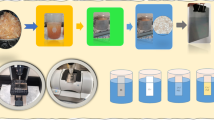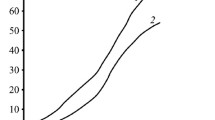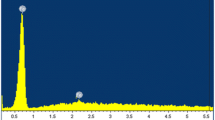Abstract
The addition of polyanions can greatly reduce the permeability of native chitosan coatings through ionic crosslinking, improving their stability and anticorrosive properties. Three different solutions made from high viscosity chitosan are used to produce coatings with a varying thickness on zinc. The native chitosan films are then ionically crosslinked with indigo carmine by dip** the coated samples in 10–3 M aqueous indigo carmine solution. The electrochemical properties of the coatings are studied by potentiodynamic polarization and electrochemical impedance spectroscopy methods. The surface morphology and elemental composition of the coated samples before and after corrosion are also investigated using SEM-EDS. As expected, the viscosity of the chitosan solutions, and, consequently, the thickness of the coatings can greatly influence their anticorrosive properties. The application of too thin or too thick films results in incomplete coating or swelling gradients with negative effects such as cracks appearing. Adequate thickness of high viscosity chitosan coatings results in inhibition efficiencies (~90%) similar to those resulting from medium viscosity chitosan.






Similar content being viewed by others
REFERENCES
Durability and Life Prediction in Biocomposites, Fibre-Reinforced Composites and Hybrid Composites, Jawaid, M., Thariq, M., and Saba, N., Eds., Woodhead Publ., 2019.
Pozzo, L.Y., Conceição, T.F., Spinelli, A., Scharnagl, N., and Pires, A.T.N., Carbohydr. Polym., 2018, vol. 181, p. 71.
Pang, X. and Zhitomirsky, I., Surf. Coat. Technol., 2008, vol. 202, p. 3815.
Feng, L. and Iroh, J.O., J. Appl. Polym. Sci., 2018, vol. 135, p. 45861.
Orzali, L., Corsi, B., Forni, C., and Riccioni, L., in Biological Activities and Application of Marine Polysaccharides, IntechOpen, 2017. https://doi.org/10.5772/66840
Medimagh, R., Aloui, H., Jemli, H., Chaabane, H., Belkahla, F., and Khwaldia, K., Polym. Sci., Ser. A, 2016, vol. 58, no. 3, p. 409.
Wang, H., Qian, J., and Ding, F., J. Agric. Food Chem., 2018, vol. 66, no. 2, p. 395.
Kangama, A., Zeng, D., Tian, X., and Fang, J., J. Chem., 2018, vol. 2018, article ID 2768474.
Arakkal, A., Aazem, I., Honey, G., Vengellur, A., Bhat, S.G., and Sailaja, S.G.C., J. Appl. Polym. Sci., 2020, vol. 138, p. 49608.
Carneiro, J., Tedim, J., and Ferreira, M.G.S., Prog. Org. Coat., 2015, vol. 89, p. 348.
Ahmed, R.A., Farghali, R.A., and Fekry, A.M., Int. J. Electrochem. Sci., 2012, vol. 7, no. 8, p. 7270.
Szőke, Á.F., Szabó, G.S., Hórvölgyi, Z., Albert, E., Gaina, L., and Muresan, L.M., Carbohydr. Polym., 2019, vol. 215, p. 63.
Das, S. and Subuddhi, U., Polym. Sci., Ser. A, 2016, vol. 58, no. 2, p. 154.
Dabóczi, M., Albert, E., Agócs, E., Kabai-Faix, M., and Hórvölgyi, Z., Carbohydr. Polym., 2016, vol. 136, p. 137.
Heakal, F.E.T. and Bakry, A.M., Int. J. Electrochem. Sci., 2018, vol. 13, p. 7724.
Smitha, B., Sridhar, S., and Khan, A.A., Eur. Polym. J., 2005, vol. 41, no. 8, p. 1859.
Berger, J., Reist, M., Mayer, J.M., Felt, O., Peppas, N.A., and Gurny, R., Eur. J. Pharm. Biopharm., 2004, vol. 57, p. 19.
Chattopadhyay, D.P. and Inamdar, M.S., Int. J. Polym. Sci., 2010, vol. 2010, article ID 939536.
Szőke, Á.F., Szabó, G., Simó, Z., Hórvölgyi, Z., Albert, E., Végh, A.G., Zimányi, L., and Muresan, L.M., Eur. Polym. J., 2019, vol. 118, p. 205.
dos Anjos, F.S.C., Vieira, E.F.S., and Cestari, A.R., J. Colloid Interface Sci., 2002, vol. 253, p. 243.
Szőke, Á.F., Szabó, G., Hórvölgyi, Z., Albert, E., Végh, A.G., Zimányi, L., and Muresan, L.M., Int. J. Biol. Macromol., 2020, vol. 142, p. 423.
Dynamics of Curved Fronts, Pelcé, P., Ed., Academic Press, 1988.
Elhefian, E.A., Elgannodi, E., Mainal, A., and Yahaya, A.H., Turk. J. Chem., 2010, vol. 34, no. 47, p. 47.
Stern, M. and Geary, A.L., J. Electrochem. Soc., 1957, vol. 104, no. 1, p. 56.
McCafferty, E., Introduction to Corrosion Science, Springer, 2010.
Chifu, E., Tomoaia-Cotisel, M., Albu, I., Mocanu, A., Salajan, M.-I., Racz, Cs., and Pop, D.-V., Experimental Methods in Chemistry and Biophysics of Colloids and Interfaces, Presa Univ. Clujeana, 2004.
Volentiru, E., Nyári, M., Szabó, G., Hórvölgyi, Z., and Mureșan, L.M., Period. Polytech., Chem. Eng., 2014, vol. 58, p. 61.
Rohindra, D.R. and Nand, A.V.J.R., South Pac. J. Nat. Appl. Sci., 2004, vol. 22, p. 32.
Oliveira, G.K.F., Tormin, T.F., de O. Montes, R.H., Richter, E.M., and Muñoz, R.A.A., Electroanalysis, 2016, vol. 28, p. 2143.
da Silva, A.K.N., Rodrigues, B.D., da Silva, L.H.M., and da Rodrigues, A.M.C., Food Sci. Technol., 2018, vol. 38, no. 3, p. 454.
ACKNOWLEDGMENTS
The authors would like to thank the financial support provided by the Romanian Ministry of National Education and Dr. Lucian Barbu Tudoran for his help in the EDS and SEM measurements.
Author information
Authors and Affiliations
Corresponding author
Rights and permissions
About this article
Cite this article
Szőke, Á.F., Szabó, G., Katona, G. et al. Correlations between the Chitosan Solution Viscosity and the Anticorrosive Protection Efficiency of Indigo Carmine-impregnated Chitosan Coatings on Zinc. Prot Met Phys Chem Surf 58, 574–584 (2022). https://doi.org/10.1134/S2070205122030224
Received:
Revised:
Accepted:
Published:
Issue Date:
DOI: https://doi.org/10.1134/S2070205122030224




